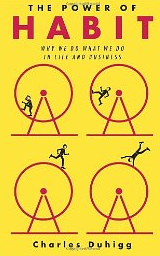I recently read “The Power of Habit: Why We Do What We Do In Life and Business” by Charles Duhigg. I think this is highly applicable to better comedy habits (writing more often, performing more often, etc) and highly recommend giving this full book a read. As always, if you like the quotes, please buy the book.
 “One small shift in Lisa’s perception that day in Cairo – the conviction that she had to give up smoking to accomplish her goal – had touched off a series of changes that would ultimately radiate out to every part of her life.” (xiv)
“One small shift in Lisa’s perception that day in Cairo – the conviction that she had to give up smoking to accomplish her goal – had touched off a series of changes that would ultimately radiate out to every part of her life.” (xiv)
“By focusing on one pattern – what is known as a “keystone habit” – Lisa had taught herself how to reprogram the other routines in her life, as well.” (xiv)
“Most of the choices we make each day may feel like the products of well-considered decision making, but they’re not. They’re habits.” (xvi)
“Habits are technically defined as: the choices that all of us deliberately make at some point, and then stop thinking about but continue doing, often every day.” (xvii)
“The habit process within our brains is a three-step loop. First, there is a cue, a trigger that tells your brain to go into automatic mode and which habit to use. Then there is the routine, which can be physical or mental or emotional. Finally, there is a reward, which helps your brain figure out if this particular loop is worth remembering for the future.” (19)
“When a habit emerges, the brain stops fully participating in decision making. It stops working so hard, or diverts focus to other tasks. So unless you deliberately fight a habit – unless you find new routines – the pattern will unfold automatically.” (20)
“Habits never really disappear. They’re encoded into the structures of our brain.” (20)
“The problem is that your brain can’t tell the difference between bad and good habits, and so if you have a bad one, it’s always lurking there, waiting for the right cues and rewards.” (20)
“It’s possible to learn and make unconscious choices without remembering anything about the lesson or decision making.” (25)
“What happens is that a once a month pattern slowly becomes once a week, and then twice a week – as the cues and rewards create a habit – until the kids are consuming an unhealthy amount of hamburgers and fries.” (26)
“Craving, it turns out, is what makes cues and rewards work. That craving is what powers the habit loop.” (33)
“First, find a simple and obvious cue. Second, clearly define the rewards.” (36)
“People are more likely to stick with a workout plan if they choose a specific cue, such as running as soon as they get home from work, and a clear reward, such as a beer or an evening of guilt-free television.” (36)
“Once a monkey had developed a habit – once its brain anticipated the reward – the distractions held no allure. The animal would sit there, watching the monitor and pressing the lever, over and over again, regardless of the offer of food or the opportunity to go outside.” (47)
“Habits are so powerful because they create neurological cravings.” (47)
“This is how new habits are created: by putting together a cue, a routine, and a reward, and then cultivating a craving that drives the loop.” (49)
“Only when your brain starts expecting the reward – craving the endorphins or sense of accomplishment – will it become automatic to lace up your jogging shoes each morning.” (51)
“Toothpaste consumers need some kind of signal that a product is working.” (58)
“Want to exercise more? Choose a cue, such as going to the gym as soon as you wake up, and a reward, such as a smoothie after each workout. Then think about that smoothie, or about the endorphin rush you’ll feel. Allow yourself to anticipate the reward. Eventually, that craving will make it easier to push through the gym doors every day.” (58)
“If you use the same cue, and provide the same reward, you can shift the routine and change the habit. Almost any behavior can be transformed if the cue and reward stay the same.” (62)
“The brain can be reprogrammed. You just have to be deliberate about it.” (77)
“If you smoke because you need stimulation, studies indicate that some caffeine in the afternoon can increase the odds you’ll quit.” (78)
“Once people learned how to believe in something, that skill started spilling over to other parts of their lives, until they started believing they could change. Belief was the ingredient that made a reworked habit loop into a permanent behavior.” (85)
“We know that a habit cannot be eradicated – it must, instead, be replaced.” (92)
“For a habit to stay changed, people must believe change is possible. And most often, that belief only emerges with the help of a group.” (92)
“Keystone habits say that success doesn’t depend on getting every single thing right, but instead relies on identifying a few key priorities and fashioning them into powerful levers… The habits that matter most are the ones that, when they start to shift, dislodge and remake other patterns.” (101)
“When people start habitually exercising, even as infrequently as once a week, they start changing other, unrelated patterns in their lives, often unknowingly.” (108)
“For many people, exercise is a keystone habit that triggers widespread change.” (109)
“This keystone habit of food journaling created a structure that helped other habits to flourish.” (121)
“When researchers studied an incoming class of cadets at West Point, they measured their grade point averages, physical aptitude, military abilities, and self-discipline. When they correlated those factors with whether students dropped out or graduated, however, they found that all of them mattered less than a factor researchers referred to as “grit,” which they defined as the tendency to work “strenuously toward challenges, maintaining effort and interest over years despite failure, adversity, and plateaus in progress.” (124)
“Self-discipline has a bigger effect on academic performance than does intellectual talent.” (131)
“Sometimes it looks like people with great self-control aren’t working hard – but that’s because they’ve made it automatic.” (131)
“Willpower isn’t just a skill. It’s a muscle, like the muscles in your arms or legs, and it gets tired as it works harder, so there’s less power left over for other things.” (137)
“This is how willpower becomes a habit: by choosing a certain behavior ahead of time, and then following that routine when an inflection point arrives.” (146)
“When people are asked to do something that takes self-control, if they think they are doing it for personal reasons – if they feel like it’s a choice or something they enjoy because it helps someone else – it’s much less taxing. If they feel like they have no autonomy, if they’re just following orders, their willpower muscles get tired much faster. In both cases, people ignored the cookies. But when the students were treated like cogs, rather than people, it took a lot more willpower.” (151)
“Simply giving employees a sense of agency – a feeling that they are in control, that they have genuine decision-making authority – can radically increase how much energy and focus they bring to their jobs.” (151)
“There are no organizations without institutional habits. There are only places where they are deliberately designed, and places where they are created without forethought, so they often grow from rivalries or fear.” (160)
“For an organization to work, leaders must cultivate habits that both create a real and balanced peace and, paradoxically, make it absolutely clear who’s in charge.” (166)
“During turmoil, organizational habits become malleable enough to both assign responsibility and create a more equitable balance of power.” (175)
“Crises are so valuable, in fact, that sometimes it’s worth stirring up a sense of looming catastrophe rather than letting it die down.” (175)
“If we start our shopping sprees by loading up on healthy stuff, we’re much more likely to buy Doritos, Oreos, and frozen pizza when we encounter them later on.” (185)
“People’s buying habits are more likely to change when they go through a major life event.” (191)
“Much of the time, we don’t actually choose if we like or dislike a song. It would take too much mental effort. Instead, we react to the cues (“This sounds like all the other songs I’ve ever liked”) and rewards (“It’s fun to hum along!”) and without thinking, we either start singing, or reach over and change the station.” (203)
“DJs started making sure that whenever “Hey Ya!” was played, it was sandwiched between songs that were already popular.” (207)
“If you dress a new something in old habits, it’s easier for the public to accept it.” (210)
“People, it turns out, often go to the gym looking for a human connection, not a treadmill.” (211)
“To modify a habit, you must decide to change it. You must consciously accept the hard work of identifying the cues and rewards that drive the habits’ routines, and find alternatives.” (270)
“The problem is that there isn’t one formula for changing habits. There are thousands.” (275)
“When environmental cues said “we are friends” – a gentle tone, a smiling face – the witnesses were more likely to misremember what had occurred. Perhaps it was because, subconsciously, those friendhsip cues triggered a habit to please the questioner.” (282)
“The reason why it is so hard to identify the cues that trigger our habits is because there is too much information bombarding us as our behaviors unfold.” (282)
“Experimenters have shown that almost all habitual cues fit into one of fives categories: Location, Time, Emotional state, Other people, Immediately preceding action. So if you’re trying to figure out the cue for the “going to the cafeteria and buying a chocolate chip cookie” habit, you write down five things the moment the urge hits: Where are you? What time is it? What’s your emotional state? Who else is around? What action proceeded the urge?” (283)
If you liked the quotes, please buy the book here.

